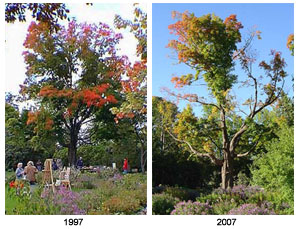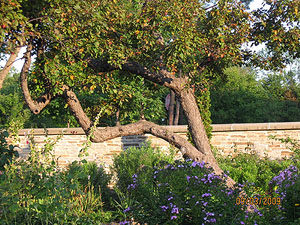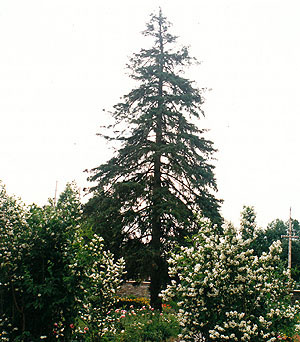|
Frequent visitors to the Garden will have noticed many major changes to Maplelawn's trees and shrubs in recent years.
From the outset, the Friends of Maplelawn Garden has been aware that replacement of many of the Garden’s largest trees and shrubs was inevitable. Notwithstanding other contributing factors, many of Maplelawn’s oldest specimens have simply reached the end of their expected life spans. |
| DECIDUOUS |
| The Sugar Maples |
While sugar maples commonly live for 75 -100 years, they can survive much longer, both naturally and with human intervention. An early 1900s photo provides the first documentary evidence of Maplelawn’s namesake species, with a line of relatively mature specimens along Richmond Road and a number of younger ones between the garden lawn and laneway.1 The latter had undergone extensive tree surgery, including installation of steel tie rods, prior to FMG’s start. Decayed cores have prevented a meaningful ring count, but other methods of determining age clearly indicate Maplelawn’s maples are far older than 100 years.
 |
| Garden Entrance Maple. Photos: Wayne Rutherford
|
Part of the original Richmond Road line of trees, the first maple (south lawn) had been removed before the creation of the FMG in 1993. With its ceremonial replanting in that same year, the NCC began the process of ensuring that maples remain a feature of the Garden companioning the 'tool shed' maple in 1998 and replacing the entrance specimen (cut down in 2007) in 2008.
The tool shed maple required the removal of a major branch in 2009. Of the original maples, only the younger one in the northeast corner remains healthy.
|
| Apples including Crab Apples |
Apple trees are one of the most long-lived fruit trees, commonly surviving up to 80 years. Crab apple trees live 25 to 60 years. Given their balanced placement within the four square design (original to the 1817 layout), some could have been planted according to Oliver’s 1936 design or in subsequent years by the Rochester family. Others may date back to the Coles (1877-1935) or even to the Thompsons, Maplelawn’s founders.1
From the outset, Maplelawn’s fruit trees (apple, crab apple and plum) have piqued the FMG’s interest, and became one of our earliest concerns. In 1996, Garden Manager Helen Brown, with Kevin Laroche, initiated the Apple Tree Grafting Project. A local nursery was hired to do grafting, with all but one of the Garden’s fruit trees used as source material. In 2001, three apple whips were planted in garden to companion existing trees or replace previously lost specimens.
Some current fruit trees are in decline. Over the past 15 years, we have watched a major branch of one crab apple slowly sag over a central path to the point it was deemed a safety hazard and was removed in 2009. In 2007, during a season of abundant fruiting and strong wind storms, another aging apple |
|
 |
| Sagging Crab Apple Branch. Photo: Eileen Hunt |
|
in the south east lost one of its three major branches. Thankfully, the replacement plantings within the garden remain vigorous and healthy.
We continue to learn more. In 2009, Garden Manager Ann Nowell reported that the crab apple specimen in northeast corner is both unique and rare. Now tentatively identified as a Geneva Crab Apple, it was developed by the Experimental Farm in Ottawa in 1936, in conjunction with the Geneva Research Station in New York State. While the precise planting date in the Garden is unknown, the development date does coincide with Warren Oliver's 1936 design for the garden. He was also employed by the Experimental Farm at that time. |
| Lilac Bushes |
| Hedge and individual specimens |
While individual lilac specimens have an average life span of 50 years, heritage varieties produce abundant true offspring. There is strong evidence that the western hedge, which forms the fourth wall to the formal garden, was part of an early 1900’s planting on both sides of the driveway.1 Although kept low and carefully trimmed for most of the Rochester era, in later years it was allowed to grow wilder.
Recently (2008-9), the NCC has markedly reduced the height of the hedge (from 15-20 feet to 10). More historically accurate, once it fills back in, the public will appreciate the newly constrained dimensions.
The placement of individual plantings within the perennial borders most probably date from the 1936 Warren Oliver plan, or after by the families. They form a major component of the balanced design of the garden. For example, lilacs are located at each corner of the four major pathways, as they enter the central circular path. In 1985, all but one of these had survived.
Early in Friends’ restoration efforts (1995-96), the balance was restored by replanting the missing one in D Section and by replacing aging specimens in the A, B and C section entrances. Lilacs along the pathway between B and D were replaced in 2008-9. At this time, the one of the oldest remaining lilacs in the garden (besides the hedge) is in the A-C entrance to the circle.
|
Mock Orange (W1, W2, A & B ) |
The typical Mock Orange will live up to 50 years. The specimens in the garden are now all in their original Oliver inspired design locations along the entrance pathway. The original plants, however, were well beyond their expected life span. They have been replaced most dramatically between 2006 and 2009, but beginning as early as 1996.
|
Hydrangea border (W1, W2) |
Hydrangeas will survive for 50 years. Maplelawn’s specimens form a border across the entrance side of both western beds. In 1985 the W1 (northwest) hydrangea border was intact, while the W2 border had been interrupted in the middle. The West 1 bed was restored in 1994 and West 2 in 1995, using predominantly existing material.
|
|
| When the FMG was created in 1993, the National Capital Commission retained primary responsibility for the care and pruning of trees and shrubs within the Garden walls. In practical terms, however, the FMG has been actively involved with the removal and replacement of smaller specimens (especially in the early years), and in their more daily care and maintenance. In addition, the Friends have initiated grafting and seedling programs to ensure the long term survival of the Garden’s major plantings. |
| EVERGREENS |
| White spruce |
 |
| White Spruce & Mock Orange. Photo: Lloyd Brown |
|
The White spruce in the south west corner of C may not be the oldest tree in the Garden, but it is the one we can most accurately date. Originally 6 inches in height, it was planted by John Cole in 1905 to commemorate his honeymoon trip1. Unfortunately, in 1998, the 100 Year Ice Storm destroyed its growing tip, and the FMG began exploring the best means to propagate an eventual replacement. |
| Cedars & Junipers |
The Eastern Red Cedars found along the main driveway, are in fact junipers: Juniperus virginiana. They survive for 50-150 years, and up to 300. There is documentary evidence that at least one specimen dates to 1856, and that the "seven trees were planted along the driveway in the early 1900's" included some cedars1. In conjunction with the Governor General’s Head Gardener Mark Burleton, they were reproduced in 2006 to ensure their survival. Three juniper saplings were placed in a holding bed in 2008.
The white cedars planted within the garden walls can survive as long as 800 years. Three are original. A number were removed along both sides of the East Wall in 1994 to allow for its restoration. So overgrown, they had in fact contributed to the decline of the wall. They were replaced according to the Oliver Plan in 1994.
A major cedar was also cut down in 1996 to restore the north beds to their original dimensions. When replanted, the beds included a new pyramidal cedar to balance the old specimen in center South. From 1996 to 2001, in accordance with the Oliver plan, pyramidal cedars were re-introduced to each end of East, and the north and south beds by the western lawn.
By the time the next 100 Year Ice Storm hits the garden, its new trees & shrubs will have matured to the point where the Garden will look as historic as it did in 1998! |
Photo Credits: Lloyd Brown, Eileen Hunt, Ann Falkner, the Rochester Family, Wayne Rutherford, N.E.M. Smith, & John Zvonar.
Source: "Annotated Chronology of Maplelawn's Trees and Shrubs, 2010", compiled by the author and other members, from FMG & NCC documents. |
|
| |
1. "Maplelawn 1817-1995 Landscape History", by Edwinna von Baeyer (NCC) |
|
|


